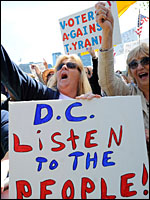The New York Times: Poll Shows Negative View of Tea Party on the Rise

The New York Times: Poll Shows Negative View of Tea Party on the Rise
By KATE ZERNIKE
Published: August 5, 2011
Little more than a year ago, most Americans did not know enough about the Tea Party to have an opinion. Now, more people have opinions, and they are hardly positive.
The percentage of people with an unfavorable view of the Tea Party in a New York Times/CBS News Poll this week was higher than it has been since the first time the question was asked, in April 2010. Forty percent of those polled this week characterized their view as “not favorable,” compared with 18 percent in the first poll.
In the first poll, a plurality, 46 percent, said they had not heard enough about the Tea Party to have an opinion (an additional 14 percent were undecided). Now, just 21 percent said they had not heard enough.
The Tea Party may have benefited early on from people not really knowing exactly what it was.
While 18 percent of people in the April 2010 poll identified themselves as Tea Party supporters, just 4 percent of those polled had actually attended a meeting or given money to the movement.
Without any central organization or policy platforms, the Tea Party became a vehicle for all sorts of amorphous frustrations. Many people came to it more out of anxiety about the economy or anger toward Washington than for any specific policy position.
On Election Day, while 4 in 10 voters said they were Tea Party supporters, many might not have known what they were signing up for.
The debate over the debt ceiling gave people a more concrete picture: Tea Party groups and members of the Tea Party caucus in the House and Senate — many of them elected in the Republican sweep of 2010 — insisted that they would not raise the debt ceiling under any circumstances. Members of the American public, meanwhile, including Tea Party supporters, were telling pollsters that they wanted compromise, not inflexibility.
Tea Party groups and lawmakers made debt reduction their priority, but many Americans said creating jobs was more important. And while many Republicans, influenced by the Tea Party, insisted that they would not allow any increases in tax revenue, a majority of Americans said debt reduction had to include higher taxes as well as lower spending.
Matt Kibbe, the president of FreedomWorks, the libertarian advocacy group that has encouraged the growth of the Tea Party movement, said he was not surprised that the negative views had grown, and blamed that change on attacks from Democrats during the debt-ceiling debate.
“It’s almost a mantra with Democrats,” he said, “ ‘Call them Tea Party extremists.’ It’s the inevitable price you pay for having an impact.”
He said that the issues that Tea Party groups had been pushing — balancing the budget, reducing the debt and cutting the size of government — continued to be popular. “These issues still animate a lot of independents and a growing number of Democrats with buyers’ remorse,” he said.
Jenny Beth Martin, a co-founder of Tea Party Patriots, a national umbrella of Tea Party groups, said people might be upset with the Tea Party because it was “holding Republicans accountable and not just Democrats.”
“That bothers some people who tend to support Republicans just because they have an ‘R’ after their name,” Ms. Martin said.
She said she had also seen an increase in her hate mail. But she still believes the Tea Party movement is winning. “Part of the reason is that we’re being effective, and we’re demanding change,” she said. “And sometimes change scares people.”
Last year, many people were attracted to the Tea Party because they were angry at the way Congress, then led by Democrats, had handled negotiations over health care legislation, and saw it as Washington politics at its worst.
In the most recent poll, most Americans took a negative view of the debt-ceiling negotiations, seeing them as “mostly about gaining political advantage.” With Republicans in charge of the House, more of the blame fell on them. And many people — a 43 percent plurality — saw the Tea Party as having too much influence on Republicans.
Perhaps not surprisingly, Democrats were most likely to have an unfavorable view of the Tea Party. But a plurality of independents, too — 40 percent — viewed the Tea Party negatively, and said it had too much influence on the Republican Party.
